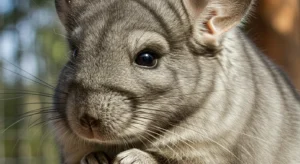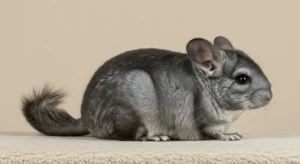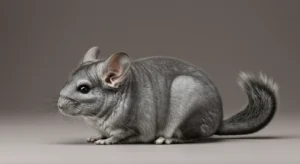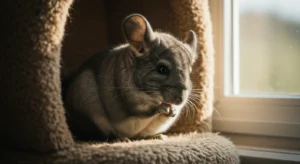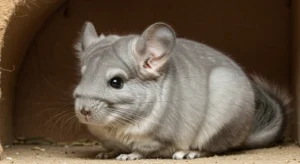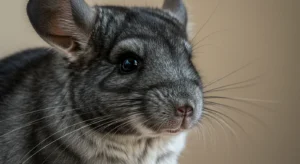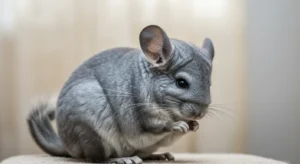Essential Cage Setup for a Happy Chinchilla
A chinchilla’s cage is their primary environment – their home, playground, and safe haven. Providing an appropriately sized, well-equipped, and safe cage is fundamental to their health, happiness, and overall well-being. Skimping on the cage setup can lead to stress, health problems, and behavioral issues. This guide covers the essentials for creating the perfect chinchilla habitat.
Importance of the Right Cage
The cage needs to fulfill several key functions:
- Space for Movement: Accommodate their natural jumping and climbing behaviors.
- Safety and Security: Protect them from household hazards and provide a secure feeling.
- Ventilation: Ensure good airflow to prevent respiratory issues.
- Containment: Keep them safely inside when unsupervised.
- Platform for Enrichment: Hold essential accessories like food, water, hides, chews, and ledges.
Size Matters: Go Big!
Chinchillas are active and need ample space, especially vertical space for jumping.
- Minimum Size (Single Chin): Generally accepted minimum is around 30″L x 18″W x 24″H, but this is truly minimal.
- Recommended Size: Taller is better than wider. Aim for cages like the Ferret Nation (single or double unit), Critter Nation, or similar large, multi-level wire cages. A double unit Ferret/Critter Nation (approx. 36″L x 24″W x 63″H) provides excellent space for one or two chinchillas.
- Bar Spacing: No wider than 1″ x 0.5″ to prevent escapes or injuries, especially for younger chins.
Bigger is always better. Provide the largest cage you can reasonably accommodate and afford. It’s a crucial investment in your pet’s quality of life. These spacious chinchilla housing recommendations directly impact activity levels.
Material and Construction
- Wire is Best: Wire cages offer the best ventilation, which is crucial for chinchillas. Ensure the wire is chew-proof (metal, not plastic coated unless very durable like Ferret/Critter Nation).
- Avoid Aquariums/Plastic Bins: Glass tanks or plastic bins provide inadequate ventilation, leading to respiratory problems and potential overheating. They are unsuitable as primary housing.
- Sturdy Build: The cage should be strong and stable, without sharp edges or points.

Flooring and Shelves/Ledges
- Solid Floors: NEVER use cages with wire mesh flooring throughout. This causes bumblefoot (sore hocks) and foot injuries. The cage bottom should be solid (plastic tray is common) or covered with safe materials.
- Ledges/Shelves: Provide multiple levels using kiln-dried pine ledges. Avoid plastic shelves unless they are very sturdy and chew-resistant (like those in Nation cages, often covered with fleece anyway). Arrange ledges to encourage jumping and exploration. Avoid treated wood or aromatic woods like cedar.
- Ramps: Ramps are often included but many chins prefer jumping. Ensure ramps are solid or cover wire ramps securely with fleece or wood.
Essential Accessories
- Water Bottle/Dish: Glass sipper bottle is often preferred (less chewable). Check daily that it works. A heavy ceramic dish can be an alternative or backup, but needs daily cleaning.
- Food Bowl: Heavy ceramic bowl (tip-resistant) or a metal bowl that clips securely to the cage bars.
- Hay Rack: Metal hay rack or manger to keep hay clean and off the floor. Stuffing hay in cardboard tubes or willow balls also works.
- Hide House: Essential for security. Wooden houses, fleece cubes, or large ceramic hides work well. Provide at least one per chinchilla.
- Chew Toys: Absolutely vital. A variety of safe wood chews, pumice stones, loofah, etc. Replenish regularly.
- Dust Bath House: A separate container for dust baths (offered 2-4 times/week, not left in cage permanently).
- (Optional but Recommended) Wheel: If providing a wheel, ensure it’s a chinchilla-safe model (15″+ diameter, solid surface, metal like Chin Spin or large Flying Saucer).
Bedding Options
- Kiln-Dried Pine or Aspen Shavings: Popular choices, good odor control. Avoid cedar (toxic oils) and untreated pine. Ensure shavings are low-dust.
- Fleece Liners: Reusable, washable, and reduce dust. Often used to cover plastic trays/shelves. Require frequent washing and swapping out. Need an absorbent layer underneath if used on solid trays. Many owners consider fleece the best chinchilla bedding for cleanliness and safety when managed properly.
- Paper-Based Bedding: Some kiln-dried paper beddings are safe, but check for low dust and no harmful additives. Can be less absorbent or odor-controlling than shavings.
Cage Placement
- Cool Location: Away from direct sunlight, heaters, or drafty windows. Maintain room temperature between 60-70°F (15-21°C).
- Quiet Area (During Day): Place in a room that’s relatively quiet during their daytime sleep hours.
- Stable Surface: Ensure the cage is on a level, stable surface.
- Away from Hazards: Keep away from electrical cords, toxic plants, or areas where other pets might harass them.
Cleaning and Maintenance
- Daily: Spot clean soiled bedding, remove old food, check water bottle.
- Weekly: Change bedding/wash liners, wipe down surfaces and ledges, clean food/water dishes thoroughly.
- Periodically: Deeper clean of the entire cage bars and structure.
Setting up the right cage from the start is a significant investment in your chinchilla’s long-term health and happiness. A spacious, safe, and stimulating environment allows them to thrive and exhibit their wonderful natural behaviors.
